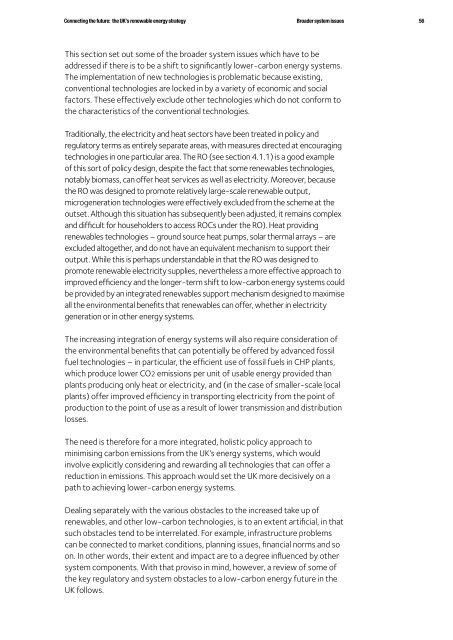Connecting the Future - Greenpeace UK
Connecting the Future - Greenpeace UK
Connecting the Future - Greenpeace UK
Create successful ePaper yourself
Turn your PDF publications into a flip-book with our unique Google optimized e-Paper software.
<strong>Connecting</strong> <strong>the</strong> future: <strong>the</strong> <strong>UK</strong>’s renewable energy strategy<br />
Broader system issues<br />
56<br />
This section set out some of <strong>the</strong> broader system issues which have to be<br />
addressed if <strong>the</strong>re is to be a shift to significantly lower-carbon energy systems.<br />
The implementation of new technologies is problematic because existing,<br />
conventional technologies are locked in by a variety of economic and social<br />
factors. These effectively exclude o<strong>the</strong>r technologies which do not conform to<br />
<strong>the</strong> characteristics of <strong>the</strong> conventional technologies.<br />
Traditionally, <strong>the</strong> electricity and heat sectors have been treated in policy and<br />
regulatory terms as entirely separate areas, with measures directed at encouraging<br />
technologies in one particular area. The RO (see section 4.1.1) is a good example<br />
of this sort of policy design, despite <strong>the</strong> fact that some renewables technologies,<br />
notably biomass, can offer heat services as well as electricity. Moreover, because<br />
<strong>the</strong> RO was designed to promote relatively large-scale renewable output,<br />
microgeneration technologies were effectively excluded from <strong>the</strong> scheme at <strong>the</strong><br />
outset. Although this situation has subsequently been adjusted, it remains complex<br />
and difficult for householders to access ROCs under <strong>the</strong> RO). Heat providing<br />
renewables technologies – ground source heat pumps, solar <strong>the</strong>rmal arrays – are<br />
excluded altoge<strong>the</strong>r, and do not have an equivalent mechanism to support <strong>the</strong>ir<br />
output. While this is perhaps understandable in that <strong>the</strong> RO was designed to<br />
promote renewable electricity supplies, never<strong>the</strong>less a more effective approach to<br />
improved efficiency and <strong>the</strong> longer-term shift to low-carbon energy systems could<br />
be provided by an integrated renewables support mechanism designed to maximise<br />
all <strong>the</strong> environmental benefits that renewables can offer, whe<strong>the</strong>r in electricity<br />
generation or in o<strong>the</strong>r energy systems.<br />
The increasing integration of energy systems will also require consideration of<br />
<strong>the</strong> environmental benefits that can potentially be offered by advanced fossil<br />
fuel technologies – in particular, <strong>the</strong> efficient use of fossil fuels in CHP plants,<br />
which produce lower CO2 emissions per unit of usable energy provided than<br />
plants producing only heat or electricity, and (in <strong>the</strong> case of smaller-scale local<br />
plants) offer improved efficiency in transporting electricity from <strong>the</strong> point of<br />
production to <strong>the</strong> point of use as a result of lower transmission and distribution<br />
losses.<br />
The need is <strong>the</strong>refore for a more integrated, holistic policy approach to<br />
minimising carbon emissions from <strong>the</strong> <strong>UK</strong>’s energy systems, which would<br />
involve explicitly considering and rewarding all technologies that can offer a<br />
reduction in emissions. This approach would set <strong>the</strong> <strong>UK</strong> more decisively on a<br />
path to achieving lower-carbon energy systems.<br />
Dealing separately with <strong>the</strong> various obstacles to <strong>the</strong> increased take up of<br />
renewables, and o<strong>the</strong>r low-carbon technologies, is to an extent artificial, in that<br />
such obstacles tend to be interrelated. For example, infrastructure problems<br />
can be connected to market conditions, planning issues, financial norms and so<br />
on. In o<strong>the</strong>r words, <strong>the</strong>ir extent and impact are to a degree influenced by o<strong>the</strong>r<br />
system components. With that proviso in mind, however, a review of some of<br />
<strong>the</strong> key regulatory and system obstacles to a low-carbon energy future in <strong>the</strong><br />
<strong>UK</strong> follows.




![[2007] EWHC 311 - Greenpeace UK](https://img.yumpu.com/22079793/1/184x260/2007-ewhc-311-greenpeace-uk.jpg?quality=85)











